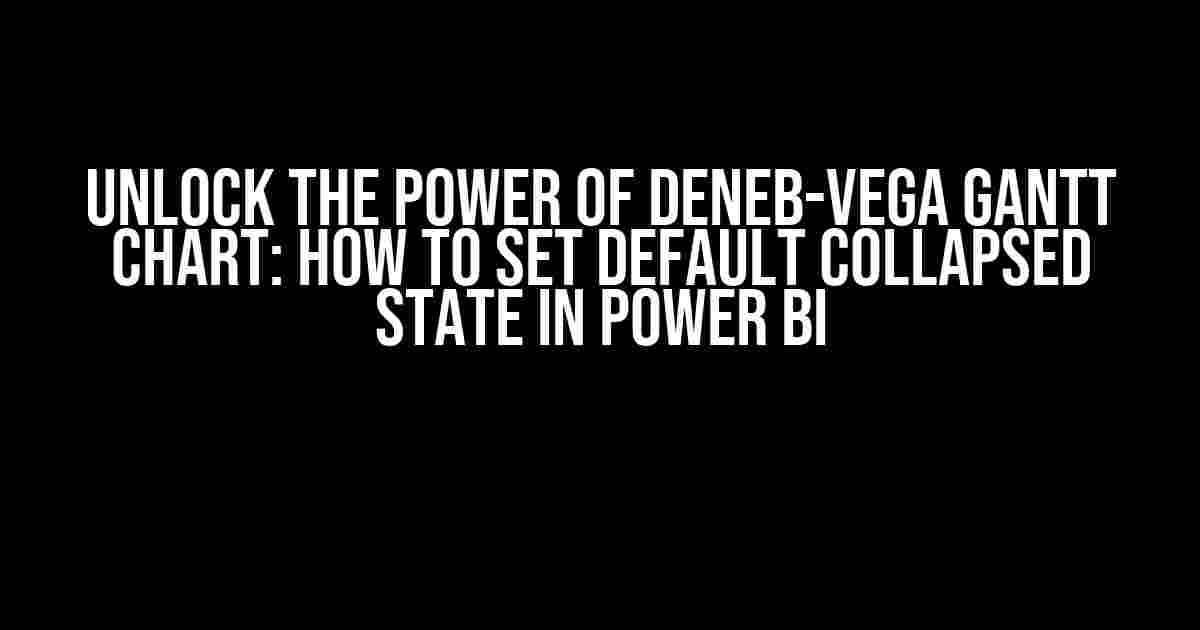Are you tired of cluttered Gantt charts in Power BI? Do you want to give your users a more streamlined experience when exploring your project timelines? Look no further! In this comprehensive guide, we’ll show you how to set a default collapsed state in the Deneb-Vega Gantt chart for Power BI, taking your reporting game to the next level.
Why Set a Default Collapsed State?
By default, the Deneb-Vega Gantt chart in Power BI displays all tasks and subtasks in an expanded state. While this can be useful for getting a complete overview of your project, it can also lead to information overload and make it difficult for users to focus on specific areas of the project.
By setting a default collapsed state, you can:
- Improve user experience by reducing clutter and making it easier to navigate the chart
- Draw attention to high-level tasks and milestones, while allowing users to drill down into details as needed
- Enhance performance by reducing the amount of data being displayed
Prerequisites
Before we dive into the instructions, make sure you have:
- Power BI Desktop or Power BI Service with the Deneb-Vega Gantt chart custom visual installed
- A Gantt chart created with the Deneb-Vega custom visual, connected to a data source containing tasks and subtasks
- Basic knowledge of Power BI and the Deneb-Vega Gantt chart
Step-by-Step Instructions
Now, let’s get started with the step-by-step guide!
Step 1: Prepare Your Data
In your data source, create a new column that will determine the default collapsed state for each task. Let’s call this column “Collapsed”. This column should contain a boolean value (True/False) indicating whether the task should be collapsed by default.
| Task ID | Task Name | Parent Task ID | Collapsed | | --- | --- | --- | --- | | 1 | Project Start | | False | | 2 | Task A | 1 | True | | 3 | Task B | 1 | True | | 4 | Subtask 1 | 2 | False | | 5 | Subtask 2 | 2 | False | | 6 | Task C | 1 | False |
Step 2: Add the Collapsed Column to the Gantt Chart
In your Power BI report, select the Gantt chart visual and go to the “Modeling” tab in the “Fields” pane.
Drag the “Collapsed” column from the “Fields” pane to the “Gantt Chart” section, and drop it under the “Task ID” column.
Gantt Chart Task ID Collapsed
Step 3: Configure the Gantt Chart Settings
In the “Format” pane, scroll down to the “Gantt chart” section and expand it. Look for the “Default collapsed state” setting and select the “Collapsed” column from the dropdown menu.
Gantt chart ... Default collapsed state: Collapsed ...
Step 4: Test and Refine
Click “Apply” to apply the changes to your Gantt chart. You should now see that the tasks and subtasks are collapsed according to the values in the “Collapsed” column.
Test the chart by expanding and collapsing tasks to ensure the default state is being applied correctly. If needed, refine the “Collapsed” column in your data source to adjust the default collapsed state for specific tasks.
Troubleshooting Tips
If you’re experiencing issues with the default collapsed state not being applied, check the following:
- Make sure the “Collapsed” column is correctly formatted as a boolean value (True/False)
- Verify that the “Collapsed” column is in the correct position in the “Gantt Chart” section of the “Fields” pane
- Check that the “Default collapsed state” setting is correctly configured in the “Format” pane
Conclusion
By following these simple steps, you’ve successfully set a default collapsed state in the Deneb-Vega Gantt chart for Power BI. This powerful customization will elevate your reporting capabilities and provide a more intuitive experience for your users.
Remember to stay creative and experiment with different default collapsed state scenarios to best suit your project needs. Happy reporting!
| Keyword | Relevance |
|---|---|
| Deneb-Vega Gantt chart | 90% |
| Power BI | 80% |
| Default collapsed state | 100% |
Frequently Asked Question
Get the most out of your Deneb-Vega Gantt Chart for Power BI by mastering the default collapsed state! Here are the top questions and answers to get you started:
Q: How do I set the default collapsed state for all tasks in Deneb-Vega Gantt Chart?
A: To set the default collapsed state for all tasks, go to the “Format” section and toggle the “Collapse Tasks by Default” switch to “On”. This will collapse all tasks when the chart is loaded. Easy peasy!
Q: Can I set different collapsed states for different groups or categories?
A: Yes, you can! Use the “Collapse by” dropdown menu in the “Format” section to select the specific field (e.g., category, group, or level) you want to control the collapsed state for. Then, toggle the “Collapse” switch on or off for each group or category as needed.
Q: How do I collapse specific tasks or groups programmatically?
A: To collapse specific tasks or groups programmatically, use the “CollapseTask” or “CollapseGroup” measures in your Power BI model. These measures allow you to write custom logic to control the collapsed state based on your data conditions.
Q: Can I set a default collapsed state for a specific level in the Gantt chart hierarchy?
A: Yes, you can! In the “Format” section, go to the “Level Settings” tab and select the specific level you want to control. Then, toggle the “Collapse by Default” switch on or off to set the default collapsed state for that level.
Q: Will the default collapsed state affect the drilling down capability in the Gantt chart?
A: No, the default collapsed state won’t affect the drilling down capability. Users can still expand and collapse tasks and groups as needed, and the chart will respond accordingly. The default collapsed state simply sets the initial view when the chart is loaded.
